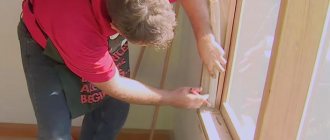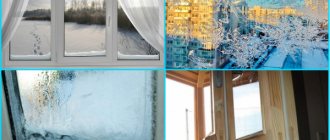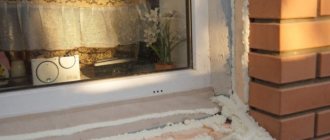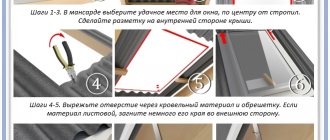No. 1. Where does the insulation of wooden windows begin?
Insulation of old wooden windows begins with examining the structure to detect cold bridges , i.e. the main routes of cold air entering the apartment. It is important to find all the weak points in order to carry out comprehensive insulation . The main cold bridges in wooden windows include:
- the junction of the window frame and sash;
- wood from which the frame is made;
- glass;
- slopes, window sills and ebb.
It is better to insulate the slopes, ebb and window sill from the outside, the remaining elements require insulation from the inside, so you will have to work hard to turn an old wooden window into an airtight one that meets current comfort requirements.
If the window inspection and its insulation are carried out efficiently, you can count on an increase in the temperature in the apartment by 3-40C if you are connected to centralized heating, or on significant cost savings if individual heating is used. In addition, it will be possible to get rid of drafts. The other side of the coin is the cessation of natural air circulation. This problem is also typical for sealed plastic windows. Its solution is periodic ventilation or installation of special valves that allow you to regulate the amount of fresh air entering the apartment.
Be prepared for the fact that for effective insulation you will have to use several of the methods described below. Let's start with the technologies that are used for internal insulation.
The most vulnerable spots in wooden windows
Before deciding how best to insulate windows, you need to figure out through which places in the windows heat escapes the most and cold comes into the room. So, the weakest points in window frames:
- The place where the glass connects to the frame.
- The place where the sash joins the window block.
- The junction of a window and a window opening.
This means that our task comes down to making all the named connection points more airtight. This way we will get rid of unnecessary cracks and block all the entrances and exits to the air - both cold and warm.
No. 2. Insulation of windows with paper
The most ancient, simple and inexpensive way . Today it is rarely used, but it is suitable if the budget is very limited. There are several variations of this insulation method:
- newspapers, wallpaper, paper are torn into pieces, twisted into ropes, which clog the cracks between the sash and the window; to simplify the task, use a ruler, knife, screwdriver or other sharp tools. Some people advise pre-wetting the flagella in water;
- paper waste is shredded, soaked in water and wrung out. To the resulting mass add 1 part clay or 2 parts crushed chalk. The result is a plastic putty that penetrates well even into the smallest cracks.
The classic old-fashioned recipe involves sealing paper insulation with strips of fabric or paper . In order for them to stick well, they were moistened with a solution of laundry soap or a homemade paste was used. The latter can be obtained by mixing water and flour in equal proportions, stirring well and bringing the resulting mixture to a boil.
A more modern option is to use masking tape or special window tape . In this case, the task is simplified, but costs still remain. Windows insulated with paper cannot be opened for ventilation if it suddenly gets warmer in the middle of winter. In the spring you will have to remove the strips of paper/fabric/adhesive tape and take out the insulation. Visible marks remain on the window frames, sometimes even some of the paint is removed, so, unfortunately, you cannot do without updating the decorative coating. However, fabric and self-adhesive paper are the easiest to remove and leave minimal marks.
Cotton wool or foam rubber for windows
Technical wool is cheaper, but it is sold in large quantities.
Using cotton wool or foam rubber, you can seal large gaps, for example, between window sashes or a sash and a wall or window sill. The cotton wool/foam rubber must be sealed on top with paper tape or special tape, because It is difficult to seal small cracks with cotton wool. In this case, the paper tape will serve not only a decorative function, but also increase the efficiency of insulation.
Average cost : cotton wool (50 rubles/200 g), foam rubber (30-35 rubles/skein).
Advantage : simplicity and lack of wet work.
Disadvantages : the cost of insulation increases (+ the price of cotton wool or foam rubber), additional finishing of the insulated seam is required. In addition: cotton wool and foam rubber absorb moisture, the work must be repeated annually, and a sealed window cannot be opened for ventilation.
How to cover windows with newspaper for the winter - video
No. 5. Insulation of a wooden window with foam rubber and sealant
A much more modern, reliable and effective method of insulation is the use of foam tape and sealing cords.
Foam tape is inexpensive, but its service life is only about 2 years. This method of insulation is optimal when sufficiently large gaps have formed between the sashes and the frame. The installation process itself is simple, but labor-intensive, since everything needs to be accurately measured and carefully glued so that the window is well insulated, but at the same time does not stop closing normally. The main advantage of this method is the ability to open the window.
The process of insulation with foam tape comes down to the following:
- measuring the required length and width of the tape. The length should correspond to the perimeter of the valves, and the compressed width should correspond to the width of the voids;
- the places on the doors where the tape will be glued must first be cleaned of dust and degreased with alcohol or acetone;
- foam rubber tapes are produced, as a rule, with a self-adhesive base, so the task is simplified and comes down to only removing the protective layer and carefully gluing the foam rubber to the designated places;
- Some experts advise additionally sealing the window with paper tape, but this loses the main advantage of the method - the ability to open the window whenever you want. An alternative solution is to glue foam rubber in several rows.
Insulation made using sealing cords . They are made from different materials:
- rubber;
- polyvinyl chloride;
- polyethylene foam;
- polyurethane.
The main advantage of a rubber seal is its price, but when the temperature drops, it can harden and break. In addition, rubber is highly wear-resistant, so it is best chosen for windows that constantly open and close. Although other types of cords are more expensive, they perform much better in terms of operation.
Sealing cords are made in different shapes - the choice depends on the size of the cracks in the window structure:
- a seal whose profile resembles the letter P is suitable for windows with medium-sized cracks;
- seal with a D-shaped profile - for sealing fairly large gaps;
- seal type E - for windows with small gaps.
Tubular seals allow you to achieve a fairly high level of sealing, do not interfere with the free opening of the window, can be left in the summer and serve for several seasons in a row. The seal may have a self-adhesive base and then its installation will be identical to the installation of foam rubber tapes described above. If you take such a seal, pay attention to the shelf life of the glue: if it comes to an end, the cord may either not stick at all or quickly peel off.
The safest thing to do is to take a separate sealant and separate glue for it, which can be used as silicone sealant. In this case, the durability of the insulation reaches 5 years.
There is one more nuance. All work with tubular profiles is carried out at temperatures above +100C, so it is better not to delay it until cold weather. The seal must be glued very carefully so as not to disrupt the opening system of the sashes.
How to prepare wooden windows for winter
With the onset of the cold season, we all begin to think about insulating our homes. To achieve this, we install central heating, install heated floors and replace windows. But the main thing during this period is to maintain warmth in the apartment, thanks to which we feel comfortable and cozy even in the most severe frosts. Most of the warm air leaves our home through the windows. In a house with beautiful wooden windows, an optimally comfortable microclimate is always maintained. Thanks to the unique properties of wood, it is easy and free to breathe in the room, since such windows do not trap air, but allow it to circulate. However, wooden windows have one significant drawback - lower heat-saving qualities, but this problem can be solved. Today we will tell you how to insulate wooden windows for the winter in order to maintain a healthy indoor microclimate.
Heat transfer mechanisms and methods of controlling them
Back in school, we learned in physics that there are three mechanisms of heat transfer: direct heat transfer (thermal conduction), convection and thermal (infrared) radiation. In a cooling apartment, all three take place: Thermal conduction - through the walls, windows and doors, the floor on the ground floor and the ceiling on the top. Infrared radiation - most of all through window glass; in block Khrushchev buildings with radiators in wall niches, up to 15% of heat loss comes from radiation through the walls. Convection - through cracks, cracks, porous materials. According to the mechanisms of heat loss, the methods of insulating the room for the winter also differ.
Where does cold air come into the house from?
Regardless of the condition of the wooden structure, it has several cold bridges, that is, paths for the penetration of flows from the street. And if you insulate one and do not eliminate the others, then you can’t count on retaining heat. Therefore, before winter comes, examine the entire wooden structure, from the frame, glass and to the window sill, for the presence of cold penetration points. In particular, examine:
- Windowsill.
- Glass.
- Slopes.
- Lintels over windows.
- Cracks in frames.
Selection of tools and materials for preparing wooden windows for winter
To make the work go quickly, you need to have everything you need on hand: a screwdriver, a hammer, a spatula, a chisel, a knife, masking tape and a brush. It is also worth taking care of hand protection and purchasing work gloves. Next, you need to choose a suitable sealant. For windows, acrylic or silicone is best. After drying, they become durable, but do not lose their elasticity, withstand large temperature changes and are not exposed to ultraviolet rays.
To increase the tightness of wooden window frames, self-adhesive seals are also used - rubber cord and foam tape. Polyurethane foam will help to cope with large gaps in the area of slopes and window sills. You can update the appearance of a wooden frame with paint. It will not only improve the aesthetics of the window, but also enhance the physical and mechanical characteristics of the wood. Our catalog contains a large selection of paints and varnishes based on oil, alkyd and acrylate, which are easily applied to both new and previously painted surfaces.
Repairing a frame in a wooden window
Repairing the frame can involve both repairing the structure itself and sealing the glass, which is not tightly pressed with dried glazing bead. Before starting work, it is better to remove the frames from the canopies and lay them out on a horizontal surface. When inspecting the removed window frame, pay attention to the existing cracks in the solid wood and the joints of the frame elements. Due to time and dampness, the corners of the frame can rot and then no seals will save you from the cold, since rotten wood is a poor heat insulator. But if the frames are intact, but there are cracks and gaps at the joints of the frame, it is necessary to seal them with acrylic (not silicone!!!), as most authors write on the Internet, absolutely not understanding the difference between these sealants.
Methods for sealing gaps between wooden window sashes and frame
Now we need to neutralize the gaps between the window sashes and the frame. To do this, mom - under the supervision of grandmother - with a screwdriver stolen from dad, purposefully hammered into these cracks scraps of all sorts of rags, cotton wool, old nylon stockings and everything else that could no longer be used in any other way. From above these crevice deposits were covered with snow-white newspaper margins (pieces with text were not suitable, as they spoiled the aesthetic appearance of the window).
Paste was used as glue, but it had to be boiled. Therefore, my grandmother believed that the most ordinary kefir would hold up perfectly to the newspaper pasting. Or soap solution. Depending on the food and manufactured goods situation in the country. Of course, in our enlightened age we need to move away from old technologies. To better insulate a window, you need to go to the store and buy an insulating self-adhesive rubber cord, which is actually not a cord, but a hollow tube. You need to remove the paper tape covering the adhesive surface of the tube, apply this very surface to the gap between the window sash and the frame, and push the tube into this gap. Of course, not with dad’s screwdriver - it’s too sharp for that, but with a special roller tool, which is also sold in the store.
Instead of a cord, you can again use foam rubber. On glue. But it has a habit of tearing when opening a window, drying in untidy pieces to vertical and horizontal surfaces, as a result of which in the spring it has to be cleaned with a kitchen knife and the areas where it is placed are washed with warm water and soap. Therefore, don’t be too lazy to go to the store for an insulating cord: it will be both neater and warmer.
Insulation of glass in a wooden window
Places where the glass touches the frame There are also gaps where the glass is inserted into the frame. They are quite small, but they are enough to allow cold air to penetrate into the home. To treat these areas, a sealant is used: The glazing beads are removed (from bottom to top). The glass is pulled out. The perimeter of the glass is cleaned and dried. The same goes for the place on the frame that comes into contact with the glass. Sealant is applied to a quarter of the frame (using a special gun). The glass is inserted and carefully pressed and secured with small nails. The leaked sealant can be manually given a neat appearance (while the sealant is fresh, it can be “ironed” with a finger dipped in water). Now you can nail a new bead, but using sealant allows you to do without it. It is enough to go over the outside of the glass again with sealant. Cleaning off carelessly applied and hardened sealant is painstaking and difficult. Therefore, it is best to use transparent rather than white silicone for windows.
Using heat-saving film to insulate a wooden window
One way to insulate wooden windows for the winter is to use heat-saving film. If condensation and ice appear on the inside of the window glass in winter, this is a sign of low thermal insulation properties. The problem is typical even for modern double-glazed windows. The film is installed on the inside of the frame, parallel to the glass. — Read more at It simultaneously performs two actions: it prevents heat loss in the form of infrared radiation and creates a thermal insulating layer of air between the film and the glass. It makes it possible to avoid the effect of “crying windows”. Installation of thermal film is simple and quick. First of all, the frame is cleaned and degreased, and double-sided tape is glued around the glass. Conventional film is sold folded in two layers (the layers are separated before use). The film is glued to the tape so that it covers the entire glass. They pull it on, not paying attention to the wrinkles that form. In this case, you should ensure that the edges of the film are securely seated and that no bubbles form. After this, hot air from a hair dryer is blown onto the film. Under its influence, it stretches and smoothes out.
Share link:
No. 6. Insulation of wooden windows using Swedish technology
This is the most progressive, modern and effective way . Windows insulated using Swedish technology are actually equivalent in terms of tightness to modern plastic windows. This method also involves the use of a seal, only for it special grooves are prepared in the window sashes.
Swedish insulation technology involves the following procedure:
- dismantling the sashes;
- cutting thin grooves around the perimeter of the valves, which is carried out with a special cutter; the size of the groove must correspond to the size of the selected seal;
- installation in the grooves of the seal (polyurethane, PVC, polyethylene foam, less often foam rubber is used). No glue is used in this case - the seal holds well due to the thickenings existing in its design;
- applying silicone sealant to the junction of the sash and glass;
- if necessary, fittings and glass are replaced;
- installation of the sashes in place.
The durability of such insulation is 15-20 years , so the labor intensity and high price of the method are fully justified. It’s worth doing such work yourself only if you have at least a little experience in carpentry, otherwise you can only make things worse. The easiest way, of course, is to entrust all the work to specialists.
Windows insulated using Swedish technology can be opened at any time of the year, their appearance does not deteriorate, and sound insulation can be considered an additional bonus.
Self-adhesive window seal
Most owners of old wooden windows prefer this type because of the optimal price/effect combination. The rubber seal is glued to the inside of the window sash. Due to the fact that the seal is hollow, it does not create problems when closing the sash. It adheres well to the frame due to the adhesive strip, which opens when glued. The seal lasts 1-2 years.
Average price : 84-100 rub./roll.
Advantage : longer service life, window operation mode is not affected, aesthetics.
Disadvantages : cost, labor intensity, you can install a low-quality seal (many fakes), the likelihood of the seal coming off the frame.
No. 7. Insulating a wooden window with sealant
This method is aimed at thermal insulation of the junction of glass and sash . It can be done with your own hands, but will require a high degree of care and precision. The procedure is as follows :
- removing glazing beads, thin slats that hold the glass around the perimeter. During dismantling, almost all glazing beads break, so it is better to buy new ones in advance, and with a reserve. Removal begins with the lower bead, then the side ones are removed, and only then the top one; for this it is convenient to use a small knife or screwdriver;
- the seat inside the sash is thoroughly cleaned of dirt and dust;
- applying silicone sealant and installing the glass in place. All work on dismantling and installing glass is carried out wearing thick gloves;
- installation of new glazing beads.
Instead of caulk, you can use window putty . The procedure remains the same, only after installing the glass, excess putty must be immediately removed with a knife. In terms of aesthetics, this method is no worse, since subsequently the joint will still be covered with a new bead.
Paper tape or fabric strip
The fastest way to eliminate a draft. You can’t count on significant insulation, but the work can be done quickly and at minimal cost.
Approximate price : 100-130 rubles/roll, strips of fabric (used material).
Advantages : cheap, high speed;
Disadvantages : minimal efficiency, tape peeling off in a draft.
How to seal windows with soap and paper (toilet) - video
No. 8. Insulating a wooden window with polyurethane foam
Polyurethane foam is used for internal and external insulation ; it fills large cracks well and is used to seal the joints between the frame and the slope, between the slope and the window sill, under the window sill, and between the frame and the top beam.
Working with polyurethane foam is not difficult, but you should know some nuances:
- filling is best done from the bottom up;
- As the foam hardens, it increases in volume, so filling the cracks costs about 1/3;
- work is carried out at air temperatures not lower than +5 and not higher than +300C;
- Polyurethane foam is destroyed under the influence of sunlight, so it must be covered with a layer of finishing material. However, it is unlikely that anyone will leave this material unfinished - it does not look very good.
Instead of polyurethane foam, you can use homemade putty . It is prepared from chalk and gypsum, which are mixed in a 1:2 ratio, and then water is added until a solution of a viscous consistency is obtained. This mixture easily fills all the cracks, and outwardly it looks much more aesthetically pleasing than polyurethane foam.
How to seal cracks
The most common problem that owners of houses with wooden windows face is the appearance of gaps between parts of the structure. They are formed as a result of changes in the geometry of the window and window opening. In some cases, it is enough to adjust the position of the sashes by tightening the fastening hinges. But most often the cracks have to be sealed. You can use a lot of available and specialized materials for this purpose.
Paper
Cellulose fibers make good insulation. You can make it yourself from toilet paper or newspapers. To do this, you need to shred the paper and fill it with water. When the mass softens, you need to remove it and squeeze it well. To make the putty more durable, add the same amount of clay and twice as much crushed chalk to the cellulose.
Sealing a window with paper is one of the easiest ways to insulate a house for the winter.
The mixture should be used immediately for its intended purpose. You can put it inside the cracks with any convenient tool, for example, a knife or a strong ruler. It is advisable to seal the sealed cracks with masking tape, soapy paper or cloth.
In this way, you can insulate your windows throughout the winter. But removing the composition from the cracks and frame will not be easy, and there will be traces on the surface that can only be removed by painting.
cotton wool
This method of insulating wooden windows for the winter with cotton wool is perhaps the fastest and cheapest. You need to tear off pieces of cotton wool and place them tightly into the gaps in the window structure. It is recommended to use a screwdriver or knife to seal small cracks.
Cotton wool is the cheapest, but also the most short-lived insulation
Upon completion of the work, it is also recommended to seal the cracks with paper or fabric tape. The taped seam is more airtight and aesthetically pleasing.
The advantage of this method is that the cotton wool can be easily removed in the spring, without losing the appearance of the window. Insulation will be effective within one season, since the wool cakes and compacts over time and under the influence of moisture, so the cracks will have to be filled annually.
Foam rubber
Insulation of old wooden windows can be done using ordinary pieces of foam rubber or special foam rubber tape with an adhesive backing . Due to the many air chambers in the pores, this material provides good thermal insulation, but does not protect against street noise.
Thermal insulation of windows using foam rubber
Pieces of foam rubber can be hammered into the cracks between the frame and the frame or laid around the perimeter of the working sash and closed tightly. If necessary, the insulation is very easy to remove.
Laying adhesive foam tape around the perimeter of the window frame
To apply adhesive tape around the perimeter of the window, you will need to remove the frame from the box. If the gaps are large, then you can apply the foam tape in several layers until a tight fit is achieved. The sashes are insulated in the same way. The disadvantage of this method is that when removing the tape, traces of glue may remain on the frame or pieces of paint may come off.
Rubber compressor
An adhesive tape made of rubber or polyurethane can last for many years. And you can insulate a window with it very quickly. The only drawback is that you will need to spend money on purchasing the tape.
The insulation has the shape of a tube with a cavity inside - this ensures that its shape is maintained even if the sash is actively used. There is no need to seal the cracks - this is also a plus .
Thermal insulation of windows using Swedish technology is a fast and reliable method of insulation, but also expensive
Similar materials are used to insulate wooden windows using Swedish technology. But before installing the tape, recesses are made around the perimeter of the frame and sashes, into which the insulation is then inserted.
No. 9. Heat-saving film for wooden windows
This method is aimed at increasing the thermal insulation qualities of glass , but today heat-saving film is also glued to a wooden frame. It works like energy-saving double-glazed windows, i.e. allows daylight into the apartment, but does not release heat. This film is made on the basis of polyester, and it receives unique properties to reflect thermal radiation thanks to metal coating. This is a transparent material that does not violate the optical properties of window glass, withstands the effects of detergents, is highly durable and makes the window safe, because if the glass is damaged, all the pieces will remain on the film.
The process of installing the film is simple, but it requires care, because it is important to stick it evenly, without bubbles, with the metallized side facing out. It is best to work with gloves so as not to leave greasy marks on the surface.
Thermal insulation film can make a window “warmer”, but cannot be used as an independent insulation material.
Features of sealing window seams
The need to insulate windows is always determined by climatic and weather factors, and sometimes by insufficient sound insulation of window structures. People living in an apartment with such windows suffer from drafts, cold and even dampness (since condensation can accumulate on the inner surface of the double-glazed windows and mold can form). High-quality sealing of seams provides effective protection of the room from these unpleasant phenomena.
Disadvantages of this kind can be caused by several reasons. Firstly, the problem is caused by incorrect installation of window frames. Not all installation specialists strictly adhere to the technology of working with polyurethane foam, using this composition without any additional protection. Secondly, the double-glazed windows themselves may not be of the best quality. In addition, loss of tightness is sometimes a natural process - “age-related” wear and tear of natural materials (wood).
In addition to maintaining heat and protecting from weather conditions, high-quality sealing of window seams allows you to correctly distribute mechanical loads and provide the necessary resistance to wind.
The main material used for insulating window frames is polyurethane foam. Its functional characteristics are quite sufficient for high-quality thermal and sound insulation of windows. But over time, the sealing composition is subject to partial destruction, as well as changes in volume under the influence of temperature fluctuations. These processes lead to a number of problems, including a violation of the window seal, incorrect operation of locking mechanisms, and even damage to the layer of plaster located in close proximity to the structure.
No. 10. We eliminate gaps in the sashes and frames
It is not enough to seal the gaps between the frame and the sashes, and between the sashes and the glass - the window will still let in cold air if there are cracks in the wooden elements . They certainly appear on wood as a result of temperature changes. It is not difficult to eliminate them; the following materials are used for this:
- paraffin. It is heated in a water bath to a temperature of about 700C, drawn up with a syringe without a needle and filled into all the cracks. Within an hour it will harden and turn into a serious barrier to drafts;
- special wood putty;
- sealant, and you can choose the material to match the color of the wood;
- homemade putty made from plaster and chalk, the recipe for which was described above.
Naturally, such thermal insulation measures will be most effective if you first remove the old decorative coating, then fill the cracks, and after that apply a new layer of finishing. Keep in mind that paint adheres worse to paraffin and sealant, so it is better to carefully remove their excess.
What else can be used for insulation?
Other materials can be used to insulate wooden windows. For example, to eliminate gaps between the frame and the sash, use:
- cotton wool twisted into bundles;
- foam strips;
- strand of fabric.
This window insulation is called the “grandmother’s” method. This is exactly what they did (and continue to do) when plastic windows had not yet been heard of. These materials are twisted into a tight bundle and, using a screwdriver or table knife, pushed into the cracks. In this regard, it is more convenient to work with foam rubber - it is pushed into any cavity.
The old method is not so elegant, but effective
Then, to completely block the access to air, a strip of paper or fabric is glued on top. Paper or cloth can be soaked in paste (dilute 1 tablespoon of flour or starch in 2 tablespoons of cold water, add a little boiling water, put on low heat, cook, stirring until transparent). The paste can be replaced with soaked laundry or cosmetic soap. You can simply put a bar of soap in warm water, rub a cloth or paper over the soaked part and stick it on the frame. After drying, the paper and fabric become much denser and almost do not allow air to pass through.
If “grandmother’s” method of insulation does not please you, you can use construction (paper) tape or paper for sealing windows with adhesive applied on one side. It turns out the same thing, but a little more expensive. But there's less fuss. But construction tape sometimes comes off poorly - with pieces of paint. But the “grandmother’s” method can be removed without problems and even paint that doesn’t adhere too well remains in place.
No. 11. How to insulate wooden windows from the outside?
Internal insulation is sometimes not enough. Slopes often need additional thermal insulation . Work on their insulation begins with the dismantling of the old finish, after which the surface is primed. The cracks can be filled with polyurethane foam; another option is to cover the slopes with polystyrene foam. After hardening, excess foam is cut off and the surface is treated with plaster. A polymer mesh is attached to the foam on top, perforated tape is placed in the corners, after which plaster is performed. All that remains is to prime and paint the slopes.
The window sill area is also sealed with polyurethane foam. A mandatory requirement is the installation of a special strip for drainage of rainwater. It should be inclined and have rolled edges so that moisture does not get on the walls or through the window. It is advisable to seal the joints between the plank and frame or slope with sealant.
It is better to insulate the area under the window sill with polystyrene foam from the outside, because in a third of cases the most heat flows away through this area.
The final touch of external thermal insulation is updating the paintwork. The old peeling layer of paint can be removed using a spatula and a hair dryer, and fresh paint or varnish can be applied instead.
Sealing wooden windows
Sealing cracks in wooden windows
Gaps in the window structure and loose fit of the frames to the opening lead to a deterioration in the microclimate of the room. This is especially noticeable in winter - the room becomes cold, damp, and fungus may appear. Sealing wooden windows will help eliminate this problem.
Its implementation includes several stages:
- fitting window frames;
- glass sealing;
- sealing the joints between the frame and the window opening.
Sealing wooden window frames using hydrophobic impregnations will stop their further deformation. The joints between the frame and the walls are sealed from the side of the building facade. How to seal wooden windows if the apartment is located above the first floor? There are several ways to seal windows at height: using an aerial platform, scaffolding, an installation cradle, and also using the climbing method.
Industrial climbers seal wooden windows and other building structures on any floor of a building. This is a reliable and economical way to seal cracks.
Prices for sealing services for wooden windows
The cost of sealing windows depends on the type of work performed, which may include applying sealant, replacing sealing rubber bands, etc. A technician who comes to you to eliminate the causes of discomfort will be able to determine the scope of work and its cost.
You can get answers to any questions you may have by calling +7 940-76-95 or by email by sending a request to our address [email protected]
Additional Information
Significant experience in the field of sealing translucent structures in various ways has been gained by the Alptekhnologii company. which has been present in this market segment since 2000.
When creating a seam between building structures, not only waterproofing materials are used, but also an insulating sealant. This avoids freezing of joints in winter.
The Alptechnologies company carries out all types of high-rise, installation, electrical, repair and construction work. Our specialists will advise you on all issues related to the provision of services, develop a technical solution, and select the necessary materials.
Why sealing work is ordered from Alptekhnologii
- We use only materials certified in Russia.
- We accept step-by-step payments for non-cash and cash payments. For large volumes of work we provide significant discounts.
- We provide safe and high-quality order fulfillment.
- We carry out work in Moscow and the Moscow region. It is possible for specialists to travel to the regions.
- We have all the documents necessary to provide industrial climber services. We are working on concluding a contract.
- We issue a written guarantee for the services performed.
Upon the customer’s call, our employee will inspect the facility, draw up a design estimate and answer the client’s questions.
or call
No. 12. Insulation of wooden windows in a wooden house
A wooden house places increased demands on the aesthetics of all work carried out. In principle, you can use any insulation technology, but be extremely careful. It is best to use a transparent sealant for thermal insulation of the junction of glass and frame, heat-saving films, fill large cracks with polyurethane foam and then seal them with casing. An excellent way to additionally insulate windows in a wooden house is to install shutters .
Cover with film
If you have done all possible types of work, but the room is still cold, you will have to use an extreme method - cover the window with film. Yes, it's ugly. But it’s better not very beautiful, but warm. This method is usually used for windows facing the backyard. We take a thick transparent plastic film, stretch it from the outside onto the window, securing it with strips from the street. Not the most aesthetically pleasing window insulation, but effective.
Ugly? But it's warm...
Why does this method work? Because an additional insulating layer of air is created between the film and the outer glass. This is the first point. The second is this. Since the film is usually nailed to the walls, it turns out that cold air does not penetrate to the frame.
Energy saving film
The same effect - an additional insulating layer - also works in the case of the recently advertised insulation of window glass using film. As you know, any room loses heat through walls, windows, roof, floor. Windows account for up to 40% of heat loss. Previously, this problem was solved by installing additional winter frames. Heat-saving film is essentially a modern substitute for such a frame. Thin double-sided tape is attached to the window frame, and a film is glued to the tape. How smooth is not the point. It needs to be heated with a hairdryer (a regular one, not a hair dryer), after which it will level out and be unnoticeable.
Special energy-saving films are sold
This simple method allows you to raise the room temperature by several degrees. The same film will prevent overheating in the summer - prevent the sun's rays from passing through the glass. The only disadvantage of this method is the inhumane price. A square meter of film costs from 350 rubles, plus you will need double-sided tape.
Is this energy efficient film different from regular film? It's hard to say until comparative tests have been carried out. Will anything change if you cover the window with regular plastic film? Hardly. The advantage of this film is that it is crystal transparent and, after heating, is invisible on the window. So this is a relatively inexpensive and easy way to raise the temperature in the room without ruining the view from the window.
Cheaper way
Almost the same effect can be achieved if you stick packaging film with air bubbles on the inside of the glass. Of course, using this film we lose transparency, but the price is not so high. The film is generally very easy to install. We moisten a piece of film cut to the size of the glass with water (from a spray bottle). Water is applied to the smooth side. We spray it on the glass. We lay the film, align it, press it, straighten it with our hands. That's it, the film is glued.
You can do it easier - stick bubble wrap on the inside of the glass
It can last for months. It can be removed without any problems - they pulled the edge and it all came off. The same piece can be used for several years, since nothing happens to it. This is a simple method that makes insulating wooden windows more effective.











